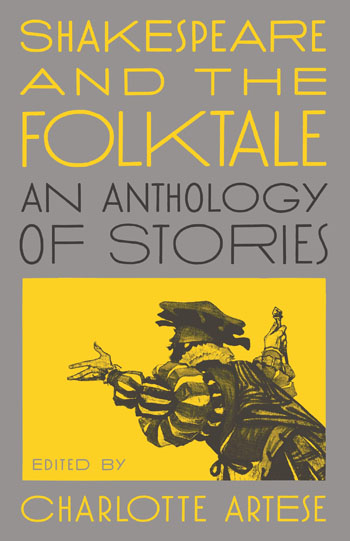|
SHAKESPEARE
AND THE FOLKTALE:
Ed Charlotte Artese
The sources of Shakespeare’s plays are well-researched. Scholarship
has been thorough for many years and even commonplace editions
contain reliable information. Artese’s undertaking is not to
identify specific sources but to range more widely in the search for
interesting antecedents. She focuses on eight plays and links each
one to folk tales from across the world which adumbrate
Shakespeare’s themes and treatments. She isn’t, however, engaged in
the rather reductionist effort of claiming a narrow group of themes
or plots which form the core of all literature. Rather she is
interested in teasing out interesting or surprising links. It may
well be, of course, that literature returns to the same territory
over and over: questions of relations between the sexes, being
fundamental to human life, would be expected to feature
prominently in world literature. In the same way, family relations
in general would be likely to appear frequently, if not inevitably
(though we have to be careful about what we mean by “family”). Power
relations too, questions of how people are governed, how the
essentials of life are organised ought to be more or less universal.
One interesting feature, however, is work. If we date the birth of
literature to Homer, which is a reasonable position, then work has
been the way people have maintained themselves and spent much of
their time for the entire history of literature ( prior to the
invention of agriculture some ten thousand years ago people lived as
hunter-gatherers and though hunting and foraging are work they
different in character from effort which technologically transforms
the earth’s resources to provide the means of life.) Work, however,
is absent from much literature: not much poetry deals with it, few
plays are set in or refer closely to workplaces and novels are
overwhelmingly about people’s lives away from work. In Shakespeare’s
time, most people earned their living from the land. If they enter
his plays they do so as the “lighter people” and, apart from the
gravedigger, are never seen at work. Nor did Shakespeare set his
plays in the place and time he knew: none is set in sixteenth
century Stratford. He had to watch his back. All the same, he
managed plenty of digs at the aspects of his culture he disliked.
Perhaps the irreverent aspects of the some the tales Artese has
unearthed helped him.
Her first choice is The Taming of the Shrew, maybe a rather
unusual one for a woman, or for a man mindful of the need to resist
centuries of sexism. She includes five precursors: The Most
Obedient Wife, a Danish tale by Svend Grundtvig; How a Bad
Daughter was Made a Good Wife a story from South Uist
collected by Angus MacLellan; the anonymous ballad The
Frolicksome Duke; Asleep and Awake from The Thousand
and One Nights and The Queen and the Tripe Seller,
an Italian story collected by Rachel Harriet Busk. None is perfectly
replicated in the play, but all have some aspects which relate to
the drama. Clearly, the essential matter: quarrelsome women,
daughters, wives and what can be done about them has arisen in the
literature of different countries over a long span. What’s
interesting is the question why. No doubt there ae women who are
quarrelsome by nature just as there are others who are gentle, men
who are blustering and men who are modest, but why should this
particular theme emerge relatively frequently? Are there as many
stories about prodigal sons? Perhaps the matter of the quarrelsome
wife gains its prominence from male preoccupations. Literature has
been a male accomplishment for centuries. Women have had to force
their way in, sometimes pretending to be men to do so. Men, of
course, don’t like quarrelsome daughters or wives, but it may be
that the unruly behaviour and difficult character is a response to
the limited potentialities provided by the culture. This is the
value of Artese’s book. It isn’t a simple curiosity: it raises vital
questions about literary culture functions, how certain themes
become ingrained and others are considered unacceptable. As with
The Taming of the Shrew so with Cymbeline: the trope of
the wager on the wife’s chastity is of ancient date. Of course,
there is the question of legitimacy here: all cultures, though they
have a very wide variety of sexual arrangements, are concerned about
legitimacy because someone has to take responsibility for children.
Hence the obsession with female fidelity once monogamous marriage
has become the norm. How common are stories about straying husbands?
The other plays included are The Comedy of Errors; Titus
Andronicus; The Merchant of Venice; All’s Well
That Ends Well; King Lear and The Tempest. That
one of the great tragedies makes it is telling. Artese points up the
link between King Lear and Cinderella. Once again,
what is notable here is the focus on feminine behaviour: a father
seeking proof of his daughters’ love. Male power and female
submission.
Artese has researched her book diligently and her choice of folk
tales helps to site the plays but more intriguingly to point to some
underlying truths about literary culture and how certain themes come
to be repeated while others get left aside.
|
